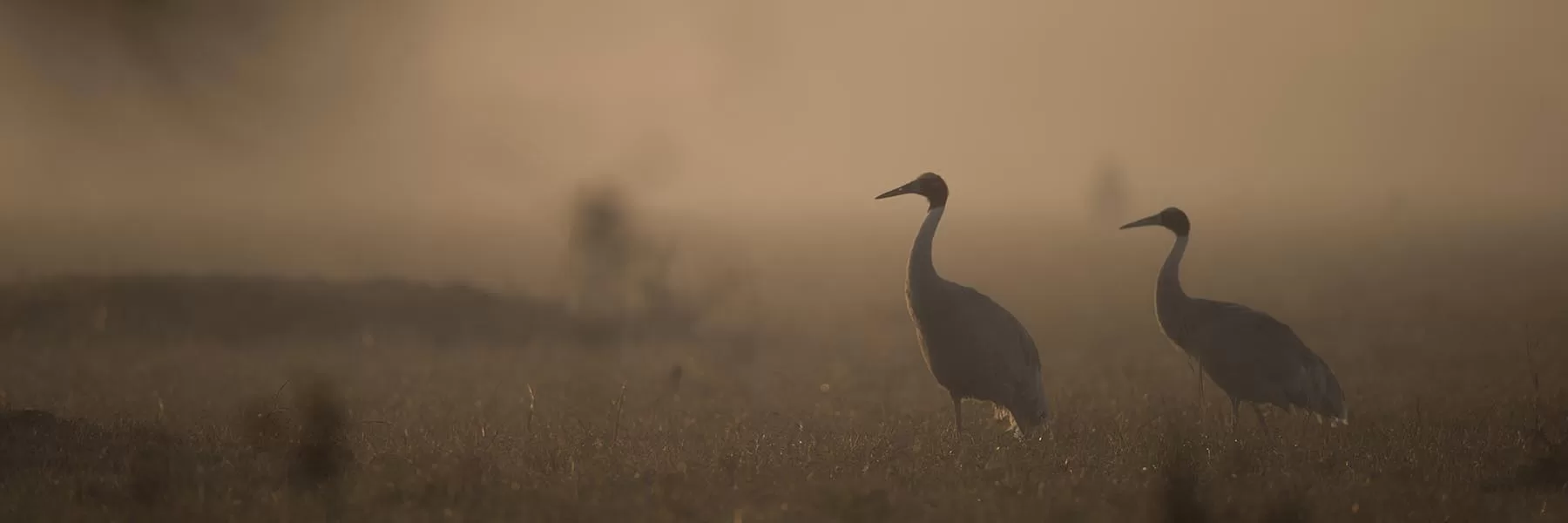Different states in India have classified different birds as their state bird. Usually few factors contribute to the choice – The bird should be found in that state, being endangered or vulnerable makes it a stronger candidate, finally we believe usually the better looking birds make to this list. However the spirit of this decision is to raise awareness about the chosen bird amongst ordinary citizens of the state and so that they also become stakeholders to its conservation.
Andhra Pradesh- Rose Ringed Parakeet
Also called Ring-necked Parakeets, these vibrantly green birds are highly sociable and appear in noisy groups. They have a long slender tail and bright red bill. In the olden days, having them as pets represented a popular status symbol in Indian culture. They are still kept as pets by many, which might explain their rapidly dwindling numbers. Parakeets are sensitive birds and require lots of care and playtime to keep them happy.
Arunachal Pradesh and Kerala- Great Hornbill
The Great Indian Hornbill is a distinctive bird with a large yellow bill and casque. The bird has a black body and a white neck. Great Hornbills prefer wet evergreen and deciduous forests of India. The Great Hornbill is the largest subspecies of hornbills on the Indian subcontinent. Their diet includes figs and insects; they can consume as much as 150 figs during one meal, and they also consume many insects.

Great Hornbill
Assam- White-winged wood duck
Known in Assamese as ‘Deo Hans’, or spirit duck because of its ghostly call, this bird has a black body and a white head thickly spotted with black and white patches on the wings. This is one of the most endangered birds in the world, with 800 surviving in the world, out of which 450 are in India. These birds reside in dense tropical evergreen forests and swampy areas. These shy birds retreat to uninhabited and inaccessible waterways outside of dusk and dawn.
Bihar- House Sparrow
This small, brown-colored bird is one of the most commonly found birds in urban cities. Males have a brightly colored body, with gray heads, white cheeks, and a black bib, while females are brown-colored and noticeably striped backs. These social birds move in groups of 8 to 10, chattering and chirping to communicate. Having lived around humans for centuries, house sparrows nest in buildings, inside crevices, and holes in walls.
Chhattisgarh and Meghalaya- Bastar Hill Myna
This is a popular talking bird, found in evergreen jungles and deciduous forests. These birds produce a wide range of loud calls, like wails, screeches, gurgles, and whistles. They have a green-glossed back and purple-tinted crown, nape, and breast. Being an omnivore, the Hill Myna feeds on seeds, berries, fruits, insects, and lizards.
Goa- Flame-throated bulbul
Endemic to southern peninsular India, the Flame-throated bulbul prefers rocky habitats and the scrub-covered hills of the Eastern Ghats. The bird has a yellow body, a black head, and a bright red throat. It feeds on berries, fruits, and insects. Flame-throated bulbuls move in flocks and stick close to cover. They have a pleasant song, characterized by a series of short and mellow notes.

Flame Throated Bulbul
Gujarat- Greater Flamingo
The largest of all Flamingo species, Greater Flamingo is distinguishable thanks to its bright red and pink colors. While these birds may reach a towering height of 61 inches, they still weigh about 3.5 kilos, which is extremely light for a creature that tall. They prefer shallow water bodies like saline lakes, salt pans, lagoons, and estuaries. These birds find safety in numbers and live and feed in flocks.
Haryana- Black Francolin
Formerly known as the Black Patridge, the Black Francolin is a game-bird belonging to the pheasant family. The males are distinctive for their black face and striking patterns, while females are paler, with an orange nape and whitish throat. These birds prefer solitary life and are shier than other francolins. These birds prefer scrubby habitats with plenty of thick vegetation. More often heard than seen, the males make a peculiar, metallic-sounding sound.
Himachal Pradesh- Western Tragopan
These elusive and scarce birds are known locally as “jujurana”, or the king of birds. These short-tailed pheasants are beautiful to behold but are difficult to spot. Males have a dark-colored body with white dots all over. Their throat is bare, with blue skin, while facial skin is red. Endemic to the Himalayan region, these birds prefer the thick undergrowth and dense vegetation of the mountains. The Western Tragopan is a highly endangered bird, and the state government has doubled down on its conservation efforts.
Jammu and Kashmir- Black-necked crane
This regal bird is a pale-bodied crane, with a black neck and dark, elongated feathers. It has a red crown, a greenish bill, and black feet. Black-necked cranes feed on plants, insects, shrimp, snails, lizards, frogs, and voles. Their numbers are dwindling because of a loss of habitat and attacks by feral dogs.
Jharkhand- Asian Koel
This peculiar and large bird prefers the interiors of dense trees and bamboo. They also inhabit coastal mangroves and shrubby areas. The males are bluish-black and shiny, with longer and slimmer body structures. The females are colorful and smaller than males. These omnivorous birds feed on caterpillars, insects, small vertebrates, and eggs.
Karnataka, Odisha, and Telangana- Indian Roller
Indian Roller is a brightly colored bird, and its belly, wings, and tails are dotted with specks of blue. They live in open grasslands and scrub forests. One can spot these pretty birds perched on trees and electrical wires. Their diet includes insects, spiders, reptiles, small snakes, and amphibians. They are famous for their acrobatic displays, especially during mating season.

Indian Roller
Madhya Pradesh- Indian Paradise Flycatcher
These medium-sized flycatcher subspecies are native to central Asia. Males have elongated, ribbon-like tails, while females have shorter tails. Some males have black plumage while others have white and blue eyes. Females have a greyish throat and cinnamon body, and they lack the blue eyes. Their primary diet includes various types of insects. These birds live in thick forests and well-wooded habitats.

Asian Paradise Flycatcher
Maharashtra- Yellow-footed green pigeon
These shy birds are sluggish and prefer to stay perched on tall trees in deciduous and evergreen forests, and feast on small figs. The yellow-footed pigeon is difficult to spot, as it prefers to stay above ground and away from any activity. However, you can recognize its unique song; a rich, low-pitched musical whistle. These birds have a blue-grey crown and yellowish olive-green body.
Manipur and Mizoram- Mrs. Hume’s pheasant
This large, forest pheasant has a greyish brown head, chestnut brown plumage, bare red facial skin, and a yellowish bill. Males have long, grayish-white tails while females have shorter, white-tipped tails. They usually live in forest openings and meadows, often in pairs or trios. The species is classified as “Near-Threatened”, because of their small, fragmented, and decreasing populations.
Nagaland- Blyth’s Tragopan
Blyth’s Tragopan is a pheasant-like bird with a short tail. Males have a yellow face with grey underpants and a bright red breast, while females are brown throughout with pale speckling. These birds inhabit dense evergreen mountain forests, feeding on the undergrowth. These vulnerable birds have tiny populations that are declining at an alarming rate.
Punjab- Northern Goshawk
These huge hawks are the largest and bulkiest accipiters. They have a gray body with a blackish crown and cheek, and white eyebrows. They prefer to live in coniferous and mixed forests and sometimes venture towards open woods. Goshawks are powerful predators; they take on their prey by putting short but powerful bursts of flight.
Rajasthan- Great Indian Bustard
Great Indian Bustards are recognizable for their black crown, brownish body, and black wings. These birds inhabit dry grasslands and scrublands. These birds tower up to 4 feet and weigh as much as 15 kgs, making them one of the heaviest flying birds in the world. These omnivorous birds are opportunistic feeders, and their diet ranges from insects and worms to small reptiles and mammals.

Great Indian Bustard
Sikkim- Blood Pheasant
Notable for vivid red coloring on the feathers of their forehead, throat, and breast, these Patridge-like pheasants are commonly found all over the Himalayas. Males have a silver-gray body with pale streaking all over their body, and females are warm-brown with an orange face. These birds are excellent runners but poor fliers, and they’re shy and secretive. They prefer remote regions in deciduous and coniferous forests.
Tamil Nadu- Emerald Dove
With bright green wings, ash-gray forehead, and a coral-red bill, these birds, belonging to the pigeon family, are shy and secretive. Males are discernible from females with their extensive silver cap. Emerald Doves feed on seeds, fruits, grass, and insects. These birds are common in tropical forests and dense wet woodlands.
Tripura- Green Imperial Pigeon
These are beautiful and large arboreal birds. Their upper body and tail are metallic green and the rest of the body is pearl gray. They occupy evergreen forests and wooded habitats. While they prefer solitude, they often forage in flocks. Their most common call is a throaty “ruooh-ruooh” sound. Their diet predominantly comprises fruits and berries.
Uttar Pradesh- Sarus Crane
With a height of 1.5 meters and a wingspan of 2.4 meters, the Sarus Crane is the tallest flying bird in the world. Their body is predominantly gray and legs are long and pale-red. Their necks and head are also red. These are amongst the least social crane species and they even turn aggressive towards intruders. They reside in shallow wetlands and cropped agricultural areas.

Sarus Crane
Uttarakhand- Himalayan Monal
This pheasant is native to Himalayan forests and shrublands. At 0.7 meters long, this is a relatively large-sized pheasant. Males have a metallic green crest and prominent white rump, while females have white tail coverts. These birds inhabit the upper temperate oak-conifer forests of the Himalayas. Their diet comprises plant roots and invertebrates.

Himalayan Monal
West Bengal- White-breasted kingfisher
Also called white-throated kingfishers, these birds have electric-blue back and wings, heavy orange bill and a predominantly brown body. They prefer a variety of locations to perch, like wetlands, agricultural fields, and lakes. They are easily identifiable from their call, which is a loud “ki-ki-ki”.
If you loved reading this story, then subscribe to our blog here (it will ask to verify your email) to get inspiring travel stories and trivia delivered to your email. Stories about wildlife trivia, cultural experiences, curated luxury hotel lists, underrated places to travel, polar journeys and much more.











